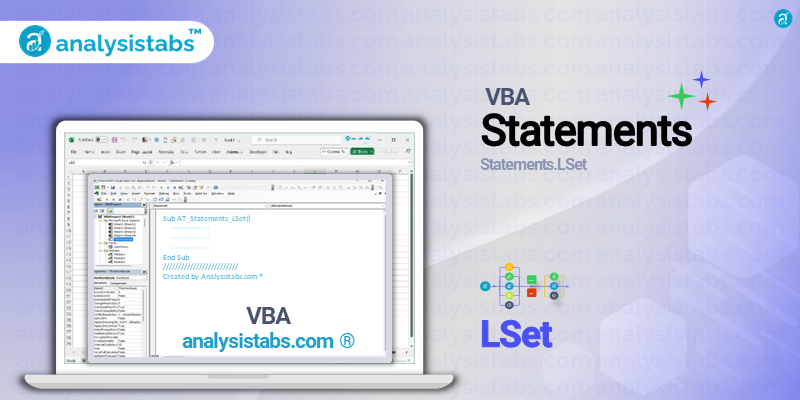VBA LSet statement, which is used to assign values to a variable’s leftmost characters or fields. In this blog post, we will explore the purpose, syntax, top 5 examples, important notes and remarks, and conclude with feedback and views on the VBA LSet statement.
VBA LSet Statement
Purpose of the LSet Statement
The LSet statement is used to assign values to the leftmost characters or fields of a variable. It is usually used when we need to modify a specific part of a string variable. The LSet statement can assign values to fixed-length strings, string arrays, and user-defined types. It is an efficient way to manipulate strings in VBA, allowing us to quickly change only the necessary characters without affecting the rest.
Syntax
The syntax for the LSet statement is –
LSet variable = expression
Here, ‘variable’ is the name of the variable whose leftmost characters or fields we want to modify, and ‘expression’ is the value we want to assign to it. The length of the ‘expression’ must be equal to or less than the length of the ‘variable.’ If the ‘expression’ is shorter, then the remaining characters of the ‘variable’ will remain unchanged.
Examples of Using the LSet Statement
Assigning a Value to Leftmost Characters of a String
Let’s say we have a string variable ‘str’ with a length of 10 characters, and we want to change the first five characters with ‘Hello.’ We can use the LSet statement as follows –
Dim str As String * 10 str = "Goodbye" LSet str = "Hello" 'The value of 'str' is now "Hellobye"
Assigning a Value to a Specific Field of a User-Defined Type
The LSet statement can also be used to modify fields in a user-defined type (UDT). Consider the following UDT –
Type Books
Title As String * 20
Author As String * 15
Year As Integer
End Type
Now, if we have an array of ‘Books’ named ‘bookList’ and we want to change the ‘Title’ of the first book to ‘New Book,’ here’s how we can use the LSet statement –
Dim bookList(1 to 5) As Books bookList(1).Title = "Harry Potter" bookList(1).Author = "J.K. Rowling" bookList(1).Year = 1997 LSet bookList(1).Title = "New Book" 'The value of 'bookList(1).Title' is now "New Book"
Assigning a Value to a Specific Field of a Variant Array
We can also use the LSet statement to modify a specific field in a variant array. Let’s say we have a variant array ‘names,’ and we want to modify the first element’s first character to ‘J.’ Here’s how we can do it –
Dim names(1 to 5) As Variant names(1) = "John" LSet names(1) = "JOHN" 'The value of 'names(1)' is now "JOHN"
Assigning a Value to a String Array
When a string array is passed to a function, it is automatically converted to a string with values separated by spaces. In such cases, we can use the LSet statement to convert the string back to a string array. Consider the following function –
Function GetNames() As String
GetNames = "John Jane Jim"
End Function
To convert the returned string to a string array, we can use the LSet statement as follows –
Dim names() As String LSet names = GetNames() 'The value of 'names' is now an array of strings - "John", "Jane", and "Jim"
Assigning Values to Multiple Fields of a User-Defined Type
The LSet statement can assign values to multiple fields of a UDT in one go. We just need to separate the fields with a comma. Consider the following function –
Function GetInfo() As String
GetInfo = "John, Doe, 35"
End Function
Here’s an example of using the LSet statement to assign values to fields of a UDT –
Type PersonalInfo
FirstName As String * 10
LastName As String * 10
Age As Integer
End Type
Dim info As PersonalInfo
LSet info = GetInfo() 'The value of 'info' is now "John" for 'FirstName', "Doe" for 'LastName', and 35 for 'Age'
Important Notes and Remarks
- The LSet statement can only assign values to the leftmost fields or characters of a variable. To change the rightmost characters, we need to use the ‘RSet’ statement.
- The data types of the ‘variable’ and ‘expression’ must be compatible. For example, if the ‘variable’ is a string, the ‘expression’ must also be a string.
- The length of the ‘expression’ must be equal to or less than the ‘variable’ length. If the ‘expression’ is longer, it will be truncated to fit the ‘variable’ length.
- If the ‘expression’ is shorter than the ‘variable’ length, the remaining characters or fields of the ‘variable’ will remain unchanged.
Concluded Post
The VBA LSet statement is a useful tool for manipulating strings, assigning values to specific fields of a UDT or variant array, and converting a string to a string array. It offers a quick and efficient way to modify data without affecting the rest. It is an important statement to have in your VBA toolkit, especially when working with Office applications.
Have you used the VBA LSet statement in your coding? How was your experience with it? Did you find it useful? Do you have any tips or insights to share? Let us know in the comments section below. Your feedback and views are valuable to us and will help us improve our future blog posts.





